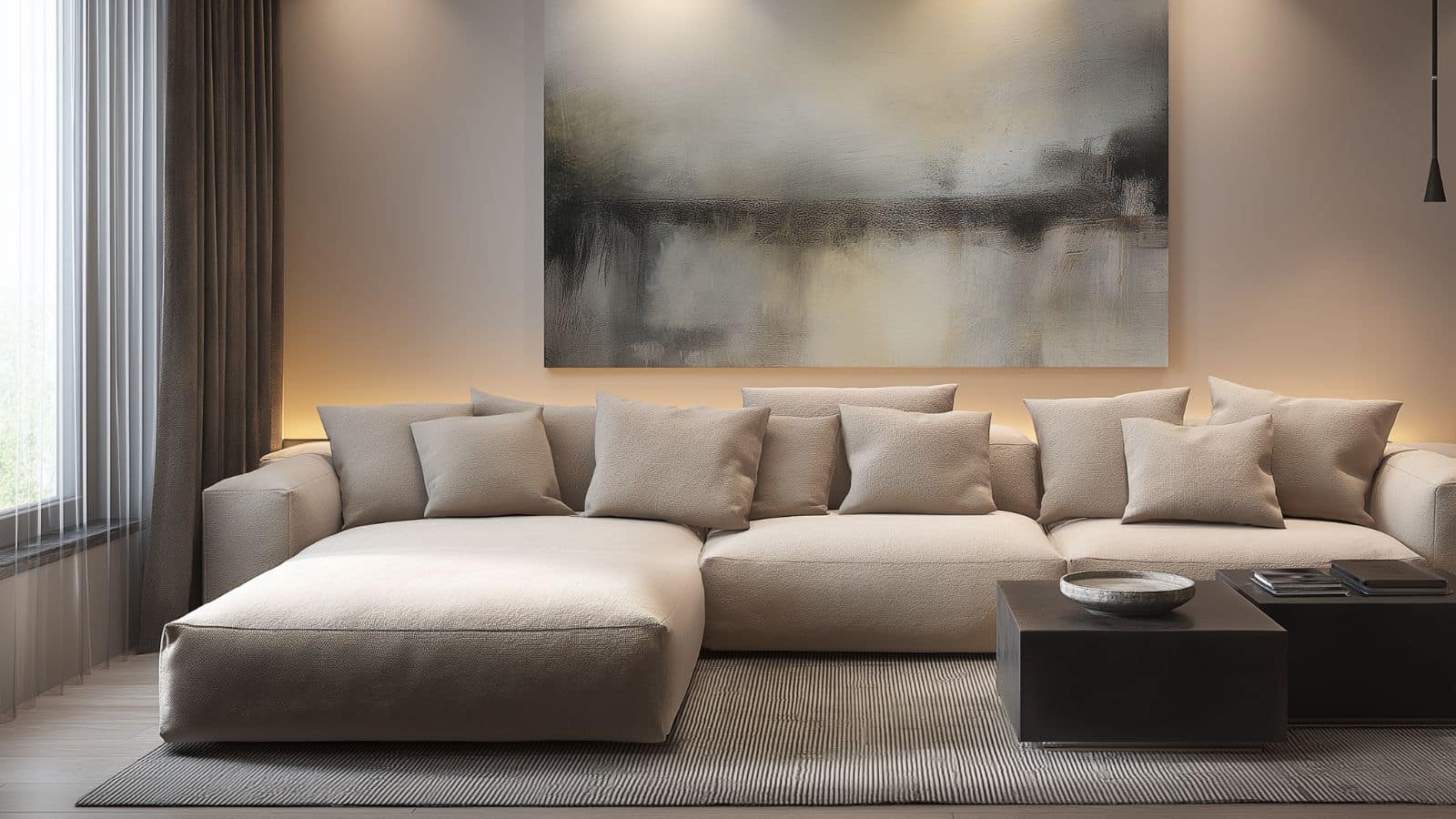Transform Your Space: Large Scale Living Room Art to Fill Blank Walls with Style
Table of Contents
Ever walk into a beautifully furnished living room, only to feel like something’s missing? Often, that missing element is the wall art—or more specifically, the scale of it. According to interior design experts, oversized artwork has become one of the most effective ways to create visual impact in modern homes. In fact, a well-placed large art piece can make a room feel more sophisticated, curated, and complete.
Blank walls can feel stark and cold, especially in open-concept spaces or rooms with high ceilings. Small framed pieces often get lost on big walls, making the area seem unfinished. That’s where large-scale living room art comes in. It not only fills negative space but also becomes a statement that ties your entire décor together.
In this article, we’ll explore how to choose, style, and position large-scale artwork in your living room. Whether you’re into abstract prints, gallery-style photography, oversized canvases, or DIY murals, you’ll find practical guidance and creative inspiration. We’ll cover expert-approved strategies, layout options, budget-friendly ideas, and even how to create custom pieces. Expect beautiful visuals, insightful tips, and all the knowledge you need to confidently elevate your living space with bold, impactful art.
Why Large-Scale Art Works So Well in Living Rooms
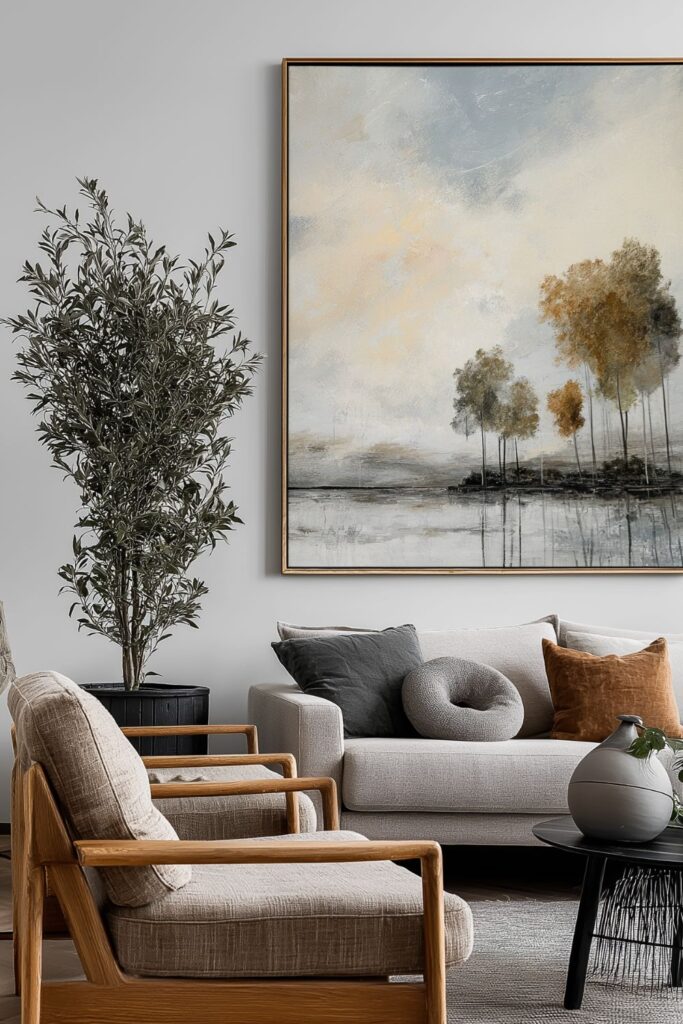
Large-scale art isn’t just visually dramatic—it plays an essential role in shaping how a space feels. One oversized piece can anchor a room, establish color themes, and offer a sense of cohesion that smaller frames often fail to deliver.
A big wall behind your sofa or above a console can easily feel empty or awkward. Filling it with a gallery wall of small items might clutter the area or require constant updating. A large piece simplifies the decision-making process and brings immediate balance and proportion.
Benefits of Large-Scale Living Room Art
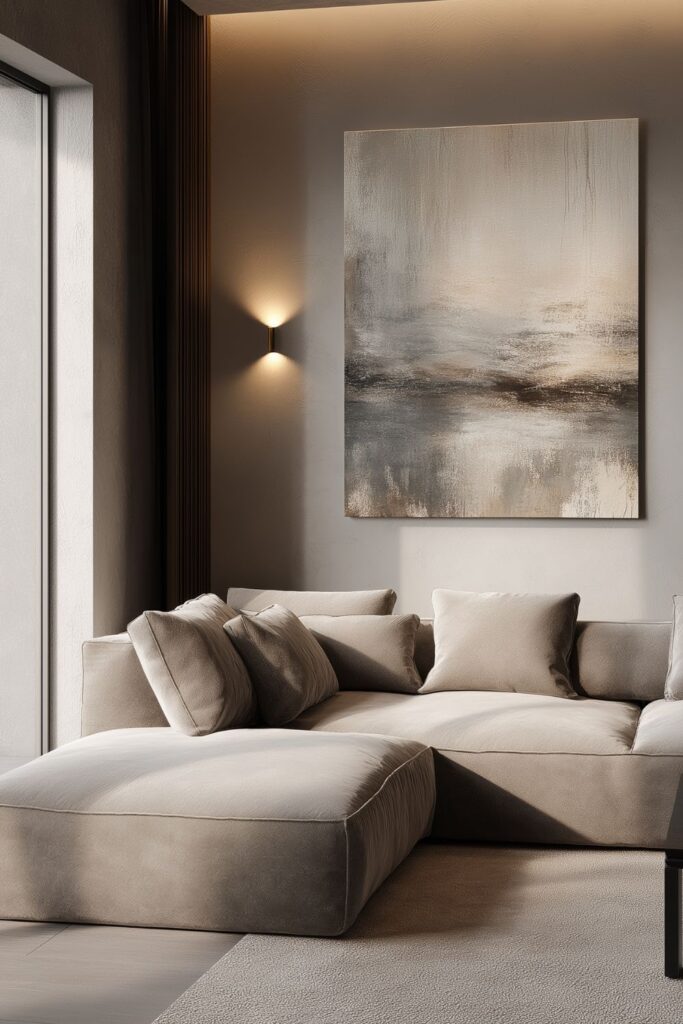
| Benefit | Description |
|---|---|
| Visual Impact | Creates an instant focal point that draws the eye and commands attention. |
| Proportional Balance | Complements tall ceilings or wide walls without overwhelming the space. |
| Style Unifier | Helps tie together colors, patterns, and materials used throughout the room. |
| Minimal Effort, Big Result | A single statement piece simplifies wall styling while delivering maximum effect. |
Oversized artwork doesn’t have to be complicated or expensive. From canvas prints to stretched fabric or framed posters, today’s market offers accessible options for every aesthetic.
Choosing the Right Type of Art for Your Space
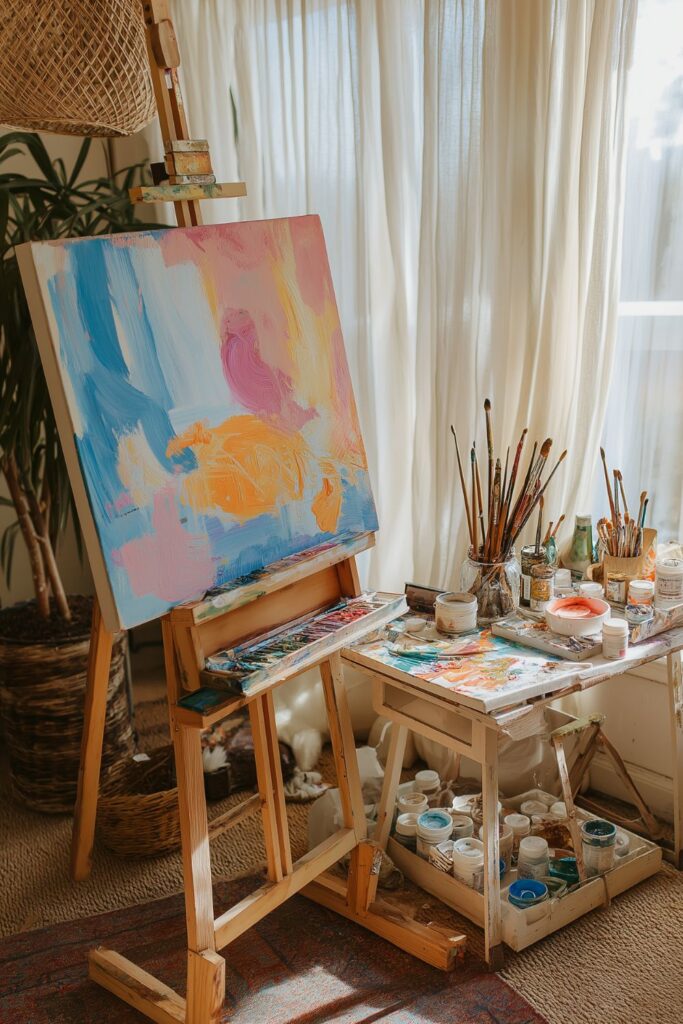
Choosing the right large-scale piece involves more than picking something you like—it must fit harmoniously within your existing interior style, color palette, and mood.
If your living room leans toward minimalism, consider monochrome abstracts or line art that subtly enhances the atmosphere. For boho or eclectic spaces, colorful textiles or layered mixed media pieces can energize the room. If your home is traditional, oversized landscapes or classical prints offer timeless elegance.
Matching Art to Design Style
| Interior Style | Suggested Large-Scale Art Types |
|---|---|
| Modern Minimalist | Monochrome abstracts, line drawings, text-based prints |
| Bohemian | Tapestries, folk art, oversized textiles |
| Traditional | Oil paintings, portraits, historical landscapes |
| Industrial | Black-and-white photography, architectural sketches |
| Scandinavian | Nature-inspired prints, soft color gradients, geometric art |
When selecting the piece, ensure it’s large enough to command attention but not so large that it dwarfs your furniture. A good rule of thumb: the art should be roughly 60–75% the width of the furniture below it.
Where to Place Large Art for Maximum Impact
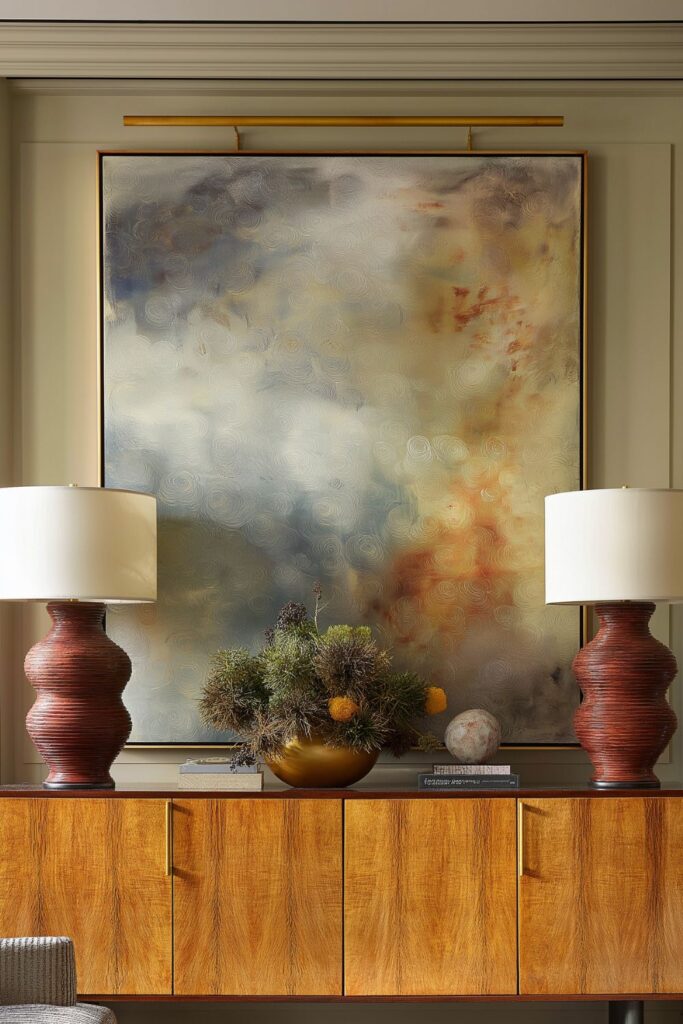
Placement can make or break the effectiveness of large-scale art. Common areas like above the sofa, behind the media console, or across from a window are ideal for framing the space and reinforcing symmetry.
Keep artwork at eye level—typically 57 to 60 inches from the floor to the center of the piece. In living rooms, it’s also important to consider seated eye level. If the artwork is hung too high, it feels disconnected from the furnishings below.
Best Locations for Oversized Art
| Wall Area | Placement Tip |
|---|---|
| Above Sofa | Leave 6–10 inches between sofa and bottom edge of frame. |
| Opposite a Window | Use art to balance incoming light and reflect visual weight. |
| Entry Wall | A bold piece here sets the tone for the entire room. |
| Behind Accent Chairs | Pairs well with cozy reading nooks or conversation corners. |
Remember, the wall you choose becomes the room’s focal point. Let the surrounding decor support the art—not compete with it.
Affordable Ways to Source or Create Large-Scale Art
Not all impactful art has to break the bank. From printable downloads to DIY projects, there are many budget-friendly ways to achieve a high-end look.
For digital art, websites like Etsy offer downloadable files that you can print in large formats and frame yourself. Fabric panels or stretched canvas over a wooden frame can make for striking DIY options. Consider painting your own abstract piece using simple tools and acrylics—it adds a personal touch and ensures originality.
Cost-Effective Art Solutions
| Art Option | Estimated Cost | Notes |
|---|---|---|
| Printable Digital Files | $5–$30 | Print at a local shop, frame or mount as desired. |
| DIY Canvas Art | $20–$100 | Requires basic art supplies, allows for full creativity. |
| Fabric Wall Hangings | $30–$60 | Choose bold patterns or textures for visual interest. |
| Oversized Posters | $15–$50 | Easy to frame or mount on foam board. |
Creative framing—like using wooden dowels, magnetic holders, or floating frames—can elevate even inexpensive pieces into gallery-worthy statements.
How to Use Color and Texture in Large Art to Complement Your Decor
When choosing large-scale art, color and texture aren’t just aesthetic details—they are tools that can change the mood and feel of your entire living room. Art becomes more than decoration; it becomes part of the room’s sensory experience.
Start by analyzing your existing palette. If your living room features mostly neutral tones, a vibrant piece of art can serve as a dramatic focal point. Alternatively, a textural monochrome work can add depth without introducing more color. Texture—whether through brushstrokes, raised surfaces, or layered media—can add a tactile element that complements plush furnishings, wood finishes, or metallic accents.
To unify the space, echo dominant colors from your art in throw pillows, rugs, or accent pieces. This technique pulls the room together without making it feel too “matchy.”
Color & Texture Integration Guide
| Art Element | Design Tip |
|---|---|
| Bold Colors | Use as an anchor; repeat in smaller accents around the room. |
| Muted Palettes | Enhance a serene, minimalist atmosphere. |
| Textured Surfaces | Adds depth and sophistication, especially in neutral or tonal spaces. |
| Metallic or Glossy Finishes | Reflect light, great for darker rooms or low-light environments. |
Experimenting with art in different finishes—matte, glossy, textured—can drastically change how it interacts with lighting and furniture, making it a dynamic part of your décor strategy.
Creating a Balanced Gallery Wall with Oversized Pieces
Large-scale doesn’t always mean one big piece. A balanced gallery wall using two or three oversized works can be just as striking. The key is maintaining proportion and spacing so the arrangement doesn’t feel crowded.
Start by selecting artworks that share a visual relationship—through color, frame style, or subject matter. For example, a trio of large black-and-white photos can bring a clean, contemporary vibe. Or combine a large central abstract with two supporting pieces that echo its palette or theme.
Use painter’s tape to map out your layout on the wall before hanging. For a traditional gallery, center pieces around a horizontal line. For a more modern look, stagger them asymmetrically.
Balanced Gallery Wall Layouts
| Layout Type | Description |
|---|---|
| Triptych | Three aligned pieces; ideal for long walls or behind large sofas. |
| Asymmetrical Grouping | Mix of large and medium pieces with varied spacing for an eclectic feel. |
| Centerpiece + Flanks | One oversized work flanked by two narrower pieces—creates architectural balance. |
Spacing between pieces should be consistent—typically 2 to 4 inches—and large enough to allow each work to breathe. Keep the overall layout centered relative to the furniture below.
Mixing Large Art with Other Wall Features
Oversized art doesn’t have to stand alone. Pair it with floating shelves, wall sconces, or even plants to create a layered, lived-in effect. Think of the artwork as the anchor, and then build out a visual ecosystem around it.
For instance, placing sconces on either side of a large painting can highlight the piece while creating ambient light. Floating shelves with styled objects—books, ceramics, or vases—can soften the formality of large framed works. Even trailing plants add a touch of organic softness to structured visuals.
Layering Large Art with Wall Accents
| Accent Element | Styling Strategy |
|---|---|
| Wall Sconces | Adds lighting and symmetry; ideal for traditional or elegant settings. |
| Shelving | Use minimal objects to avoid overshadowing the art. |
| Hanging Plants | Adds movement and natural contrast to static artwork. |
| Mirrors | Reflect light and complement bold artwork without competition. |
This mixed approach works especially well in rooms with limited wall space or in transitional areas like open-concept living/dining rooms.
Conclusion
Large-scale living room art is more than a decorating trend—it’s a powerful way to shape space, convey personality, and bring visual harmony to your home. Whether you’re investing in a gallery-worthy canvas or crafting your own DIY statement, the key is choosing pieces that resonate with your style and scale them appropriately.
By understanding placement, proportion, color dynamics, and texture, you can transform even the blandest wall into a focal point that brings your entire living room to life. Don’t be afraid to think big—the right oversized artwork can truly redefine how your space feels.

